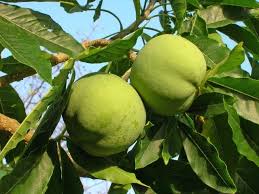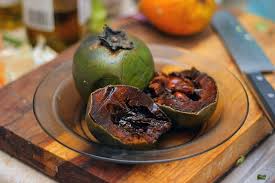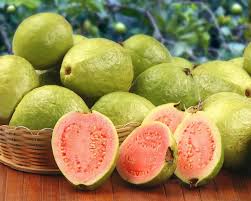Sapotes: History, Nutrition, Health Benefits and Growing Guide
Sapotes, scientifically known as Pouteria, are a fascinating group of tropical fruit-bearing trees and shrubs. These plants belong to the Sapotaceae family, and they are widely distributed in tropical regions around the world. Sapotes are renowned for their delectable fruits, each possessing a unique flavor profile and nutritional benefits.
Within the diverse Sapote genus, there are several notable species, each with its distinct characteristics. One such species is the Mamey Sapote (Pouteria sapota), known for its large, football-shaped fruits with a rough, russet-brown skin. The Mamey Sapote’s sweet and creamy orange flesh has a taste often described as a blend of sweet potato, pumpkin, and almond.
Another noteworthy member of the Sapote family is the White Sapote (Pouteria campechiana). This species bears small, greenish-yellow fruits with a custard-like texture and a mild, sweet flavor. The White Sapote is valued not only for its tasty fruits but also for its ornamental qualities, making it a popular choice in tropical gardens.
Sapotes thrive in warm, tropical climates, where they receive abundant sunlight and well-drained soil. These trees are known for their adaptability, growing in diverse ecosystems ranging from rainforests to mountainous regions. Cultivating Sapotes can be a rewarding endeavor, as they provide not only delicious fruits but also contribute to the lush beauty of tropical landscapes.
One of the remarkable aspects of Sapotes is their nutritional content. These fruits are rich in vitamins, minerals, and dietary fiber. Mamey Sapote, for instance, contains essential nutrients such as vitamin C, vitamin A, potassium, and fiber, making it a wholesome addition to a balanced diet.
Beyond their culinary and nutritional significance, Sapotes have cultural importance in various regions. Indigenous communities often incorporate Sapotes into traditional dishes and ceremonies, emphasizing the cultural relevance of these fruits. Additionally, Sapotes may have medicinal applications in some traditional practices, showcasing their multifaceted role in local customs.
With their diverse species, delectable fruits, and nutritional benefits, Sapotes contribute to the rich tapestry of tropical ecosystems. Whether enjoyed for their culinary delights, cultivated for ornamental purposes, or valued for their cultural significance, Sapotes hold a special place in the hearts of those who appreciate the wonders of tropical biodiversity.
Read Also: Small Ruminants: Sheep and Goats Classification
The History of Sapotes

The history of Sapotes traces back to ancient times, as these tropical fruits have been cultivated and cherished in various parts of the world. While the exact origins may be challenging to pinpoint due to their widespread distribution, historical records and archaeological findings suggest a rich history intertwined with human cultivation and appreciation.
Indigenous communities in tropical regions are believed to be among the first to discover and cultivate Sapotes. These early cultivators likely recognized the fruits’ nutritional value and versatile uses, incorporating them into their diets and cultural practices. The Mamey Sapote, for example, has historical ties to regions in Central America, where it has been cultivated for centuries.
As trade and exploration expanded, Sapotes found their way into different parts of the world. European explorers and colonizers encountered these exotic fruits during their voyages, leading to increased global awareness of Sapotes. The exchange of plants and agricultural knowledge during the age of exploration played a crucial role in the dispersion of Sapotes to new territories.
In the 19th and 20th centuries, botanical enthusiasts and horticulturists further contributed to the spread of Sapotes. The introduction of these tropical plants to botanical gardens and plant collections allowed for broader research and appreciation. As a result, Sapotes gained recognition not only for their delicious fruits but also for their ornamental and ecological qualities.
Today, Sapotes continue to be cultivated and enjoyed worldwide. Modern agricultural practices, advancements in horticulture, and global trade networks have further facilitated the availability and accessibility of Sapotes in various regions. Their cultural significance persists, with many communities integrating Sapotes into traditional dishes and celebrations.
The history of Sapotes is a tale of cultivation, exploration, and cultural exchange, highlighting the enduring appeal of these tropical fruits across different epochs and geographic locations. As they remain cherished for their unique flavors and contributions to local customs, Sapotes continue to weave a flavorful thread through the tapestry of human history.
The Nutritional Values of Sapotes

Sapotes offer a rich array of nutritional benefits, making them not only delicious but also a valuable addition to a balanced diet. The nutritional composition varies slightly among different species, but here’s a general overview of the key components found in various Sapotes:
1. Vitamins: Sapotes are a good source of essential vitamins. They often contain vitamin C, known for its antioxidant properties that support the immune system. Additionally, some Sapotes, like the Mamey Sapote, provide vitamin A, contributing to eye health and skin maintenance.
2. Minerals: These tropical fruits are rich in minerals, including potassium. Potassium is crucial for maintaining proper heart function and helps regulate blood pressure.
3. Dietary Fiber: Sapotes are generally high in dietary fiber. Fiber is essential for digestive health, promoting regular bowel movements and aiding in the prevention of constipation.
4. Carbohydrates: The primary energy source in Sapotes comes from carbohydrates. The natural sugars found in these fruits provide a quick energy boost, making them a delightful and nutritious snack.
5. Healthy Fats: Some Sapotes, like the Mamey Sapote, contain healthy fats, including monounsaturated fats. These fats contribute to heart health and can be part of a well-balanced diet.
6. Protein: While not a significant source of protein, Sapotes do contain trace amounts, contributing to the overall nutritional content.
It’s important to note that the nutritional profile can vary between different Sapote species. For example, the White Sapote may have a slightly different nutrient composition compared to the Mamey Sapote. However, across the board, Sapotes are known for their delicious taste and the nutritional goodness they bring to the table.
Incorporating Sapotes into a diverse and well-rounded diet can be a flavorful way to enhance nutritional intake, providing a mix of vitamins, minerals, and dietary fiber. Whether enjoyed fresh or incorporated into various culinary creations, Sapotes stand out not only for their tropical taste but also for the wholesome nutrients they offer.
Read Also: Complete Guide on Sheep and Goats Production
The Health Benefits of Sapotes

Sapotes offer a range of health benefits, thanks to their rich nutritional content and unique phytochemicals. While individual health advantages may vary among different species, here are some common benefits associated with the consumption of Sapotes:
1. Antioxidant Properties: The presence of vitamins, such as vitamin C and A, in Sapotes provides powerful antioxidants that help combat oxidative stress in the body. Antioxidants play a role in neutralizing free radicals, potentially reducing the risk of chronic diseases.
2. Heart Health: The potassium content in Sapotes supports heart health by helping regulate blood pressure. Maintaining a healthy blood pressure level is crucial for reducing the risk of cardiovascular diseases.
3. Digestive Health: High dietary fiber content in Sapotes promotes digestive health by preventing constipation and supporting regular bowel movements. Fiber also aids in maintaining a healthy gut microbiota.
4. Immune System Support: Vitamin C, found in many Sapote species, is known for its immune-boosting properties. Adequate vitamin C intake supports the body’s defense against infections and illnesses.
5. Eye Health: Vitamin A in Sapotes contributes to maintaining good vision and overall eye health. It plays a vital role in the function of the retina and may help prevent age-related macular degeneration.
6. Nutrient Density: Sapotes are nutrient-dense fruits, providing essential vitamins, minerals, and healthy fats. Including them in a balanced diet contributes to overall nutrient intake and may help prevent nutritional deficiencies.
7. Weight Management: The dietary fiber in Sapotes contributes to a feeling of fullness, potentially assisting in weight management by reducing overall calorie intake and promoting satiety.
8. Skin Health: Vitamins and antioxidants in Sapotes can contribute to healthier skin by protecting against damage from environmental factors and promoting collagen production.
It’s important to note that while Sapotes offer various health benefits, individual responses to these fruits may vary. Additionally, a well-rounded and diverse diet, along with a healthy lifestyle, plays a crucial role in overall health and well-being. Including Sapotes as part of a balanced diet can be a flavorful way to enjoy their nutritional advantages.
How to Grow Sapotes (Growing Guide)
Growing Sapotes can be a rewarding experience, and here’s a simplified guide to help you cultivate these tropical fruits successfully:
1. Climate and Soil: Sapotes thrive in warm, tropical climates with temperatures ranging between 60°F to 80°F (15°C to 27°C). Choose well-draining soil rich in organic matter. Sapotes prefer slightly acidic to neutral soil pH.
2. Planting: Plant Sapote seeds or seedlings in a location with full sunlight. Ensure proper spacing between trees to allow for healthy growth. Dig a hole slightly larger than the root ball of the seedling and backfill with soil, ensuring the plant is at the same depth as it was in the container.
3. Watering: Keep the soil consistently moist, especially during the growing season. However, avoid waterlogged conditions, as Sapotes prefer well-drained soil. Water newly planted saplings more frequently until they establish a robust root system.
4. Fertilization: Apply a balanced, slow-release fertilizer during the growing season to provide essential nutrients. Consider organic fertilizers to promote healthy soil and minimize environmental impact.
5. Pruning: Prune Sapote trees to shape them and remove any dead or diseased branches. Pruning can also help improve air circulation.
Start pruning when the tree is young to encourage a strong and well-structured framework.
6. Mulching: Apply a layer of organic mulch around the base of the tree to conserve moisture, suppress weeds, and regulate soil temperature.
7. Protection from Frost: Provide protection from frost, especially for young Sapote trees, as they are sensitive to cold temperatures.
Consider using frost cloth or other protective measures during chilly periods.
8. Pest and Disease Control: Monitor for common pests such as aphids or scale insects. Use organic insecticides if necessary. Practice good sanitation to minimize the risk of fungal diseases. Remove and dispose of any affected plant material.
9. Harvesting: Sapotes are typically harvested when the fruits are fully ripe. This timing may vary depending on the specific Sapote species.
Harvest by hand, avoiding damage to the fruit.
10. Patience: Growing Sapotes may require patience, as these trees can take several years to reach maturity and start bearing fruit.
Remember, local conditions may influence the specific care requirements for Sapotes, so it’s beneficial to adapt these guidelines based on your region’s climate and soil characteristics. Regular observation and care will contribute to the successful cultivation of healthy and productive Sapote trees.
Read Also: Reasons Why You Should Make Fitness Your Lifestyle









